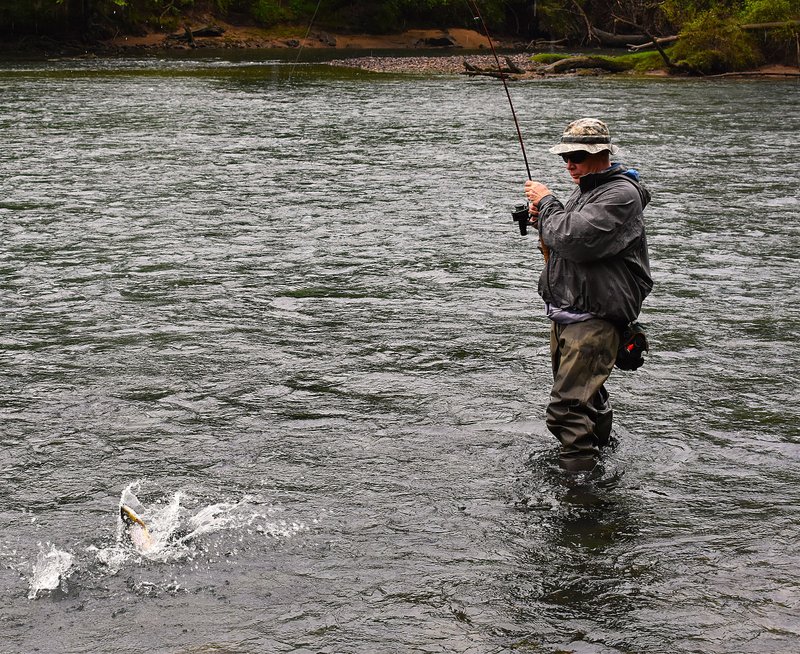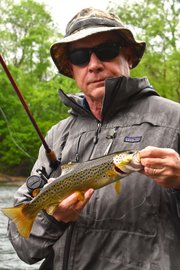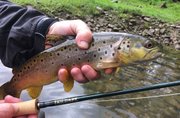Reasonable men would have heeded the darkening sky and distant thunder and dashed to the boat for his rain jacket.
Reasonable men wouldn't have stood unprotected in a cold, pouring rain.
Reasonable men would have quit about 20 minutes too soon.
This lesson of unreasonable perseverance occurred during the year's first visit to the Little Red River to chase trout with Rusty Pruitt. I was excited and eager to break in a new 4-weight rod from Reilly Rod Crafters, a 9-foot, four-piece expression of my deepening passion for fly fishing.
Like many anglers who gravitate to favorite spots, Pruitt and I had settled into a productive by stale routine in the upper part of the Little Red. We needed a change.
"We could put in at the dam and fish down to Cow Shoals ..."
"Beeg feesh," Pruitt said.
"Or we could put in at Lobo and fish Mossy Shoal," I continued. "It's overlooked, but it's a neat place."
Beau Saunders, the new owner of the Cabins at Lobo Landing Resort, said hydropower generation was done for the day and that fishing conditions would be very good at Mossy Shoals.
"You can go down to the island and tie up your boat, and you can work both sides of the river," Saunders said.
The weather was cloudy, warm and humid when we launched the War Eagle, and the water was falling. When we entered the Mossy Shoal special regulations area, we beached the boat.
Pruitt always starts at the head of a shoal, and I always take the bottom. With a massive caddis hatch in progress, Pruitt tied on his favorite Flashback. I used a Chronic, a beaded hare's ear nymph with subtle streaks of green and gold.
Before casting, I looked for breaks, eddies and flat spots on the surface that betray the riverbed's texture. I was most interested in a spot across the river where two small islands split the channel. Crosswater flows between the islands, and the main flow merges below the second island, creating a deep run that cuts beside the right bank.
At the end of my fly line was a 7-foot tapered leader with a 3-foot, 5X tippet. The tippet was a bit heavy for the small fly, but manageable. My strike indicator was at the top of the leader, almost to the fly line.
The technique was simple. Cast far upstream and let the current carry the fly downstream on a dead drift. This requires rapidly taking in slack line (mending) to prevent line from bowing or trailing. The former catches water downstream of the fly and speeds the drift. The latter creates drag and slows the drift.
When the fly reaches the end of its drift, slowly lift the rod tip to begin a new cast. Trout often strike when the fly rises because it resembles an imago heading for the surface. That's when insects are most likely to be eaten.
Hours passed without a bite.
"They ought to be eating like crazy with all these caddis," Pruitt said impatiently.
"This hatch has been going on for several days," I replied. "They're probably eating in spurts, and with a bright moon, they're probably eating a lot at night, too."
About then came my first tumble into the river. It happened when my foot plunged knee deep into silt and planting me off balance. The current pushed me forward, and down I went, much to Pruitt's amusement.
It happened again about 30 minutes later as I eased across the river to the cut behind the second island. Pruitt fished directly across the river.
We'd been at those stations for about an hour when the wind began to howl. Thunder rumbled in the distance, and I thought it might be wise to leave the water.
I would have, too, except trout began rising. Some were big fish, and they were close. I caught two rainbows in succession as drizzle dimpled the surface. The wind quickened, and the thunder drew nearer.
My strike indicator plunged, and I lifted the rod on a fish that refused to yield. The stocker rainbows surrendered fairly fast, but this fish had power and stamina. It went upstream and downstream. It circled me. When it got too feisty, I fed out line through my fingers to let it run.
I finally prevailed and brought to hand a slim, muscular 14-inch brown trout, my first on a fly rod.
As soon as I released it, the thunder clapped and the clouds opened. Pruitt and I were instantly soaked, but I more so because I fell twice more in the river as I rushed across for my jacket. I was, of course, thrilled to provide so much entertainment for Pruitt, but the best was yet to come.
When the rain passed, Pruitt switched to a light spinning rig with a Tennessee shad crappie jig. A brown trout pounced on it immediately. Pruitt released the fish in still water next to the bank. He put down the rod with the lure in the water to attend to something in the boat, but the same fish grabbed the jig and hooked itself again.
"You greedy little pig!" Pruitt shouted, laughing.
We spent the next couple of hours trolling crappie jigs up to Libby Shoals. I used a chrome/red/black combination called a Gee Whiz. Pruitt used several items, and we caught trout almost until dark. We lost count, but the tally was about 40.
I was stiff, sore and exhausted from having wrenched my lower back during one of my pratfalls, and we were both borderline hypothermic.
Reasonable men would have rushed hours ago back to a heated truck, dry clothes and a hot supper.
Reasonable men wouldn't have had nearly as much fun.
Sports on 05/06/2018


